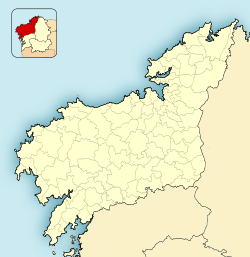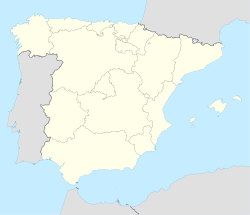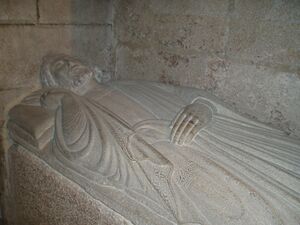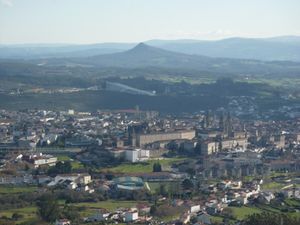سانتياجو دى كومبوستلا
Santiago de Compostela | |||
|---|---|---|---|
City and Municipality | |||
 From the top: Santiago de Compostela Cathedral, Praza das Praterías, Alameda Park, City of Culture of Galicia, Monastery of San Martiño Pinario, Pazo de Raxoi | |||
 Location of the municipality of Santiago de Compostela within Galicia | |||
| الإحداثيات: 42°52′40″N 8°32′40″W / 42.87778°N 8.54444°W | |||
| Country | |||
| Autonomous Community | |||
| Province | A Coruña | ||
| Parishes | |||
| الحكومة | |||
| • النوع | Mayor–council | ||
| • الكيان | Council of Santiago | ||
| • Mayor | Xosé Sánchez (PSOE) | ||
| المساحة | |||
| • City and Municipality | 220 كم² (80 ميل²) | ||
| المنسوب | 260 m (850 ft) | ||
| التعداد (2020)[1] | |||
| • City and Municipality | 97٬849 | ||
| • الكثافة | 440/km2 (1٬200/sq mi) | ||
| • العمرانية | 183٬855 | ||
| صفة المواطن | Santiagan santiagués, -guesa (gl / es) compostelán, -á (gl) compostelano, -na (es) | ||
| منطقة التوقيت | CET (GMT +1) | ||
| • الصيف (التوقيت الصيفي) | CEST (GMT +2) | ||
| مفتاح الهاتف | +34 | ||
| الموقع الإلكتروني | santiagodecompostela | ||
| Click on the map for a fullscreen view | |||
سانتياگو ده كومپوستلا (إسپانية: Santiago de Compostela [أ]؛ بالعربية: شنت ياقب) أو كومبوستلا هي عاصمة منطقة الحكم الذاتي جليقية، اسبانيا. The city has its origin in the shrine of Saint James the Great, now the Cathedral of Santiago de Compostela, as the destination of the Way of St. James, a leading Catholic pilgrimage route since the 9th century.[3] In 1985, the city's Old Town was designated a UNESCO World Heritage Site.
Santiago de Compostela has a very mild climate for its latitude with heavy winter rainfall courtesy of its relative proximity to the prevailing winds from Atlantic low-pressure systems.
المدينة
According to a medieval legend, the remains of the apostle James, son of Zebedee were brought to Galicia for burial, where they were lost. Eight hundred years later the light of a bright star guided a shepherd, Pelagius the Hermit, who was watching his flock at night to the burial site in Santiago de Compostela.[4] This site was originally called Mount Libredon and its physical topography leads prevalent seaborne winds to clear the cloud deck immediately overhead.[5] The shepherd quickly reported his discovery to the bishop of Iria, Theodemir.[4] The bishop declared that the remains were those of the apostle James and immediately notified King Alfonso II in Oviedo.[4] To honour St. James, the cathedral was built on the spot where his remains were said to have been found. The legend, which included numerous miraculous events, enabled the Catholic faithful to bolster support for their stronghold in northern Spain during the Christian crusades against the Moors, but also led to the growth and development of the city.[4]
Along the western side of the Praza do Obradoiro is the elegant 18th-century Pazo de Raxoi, now the city hall. Across the square is the Pazo de Raxoi (Raxoi's Palace), the town hall, and on the right from the cathedral steps is the Hostal dos Reis Católicos, founded in 1492 by the Catholic Monarchs, Isabella of Castille and Ferdinand II of Aragon, as a pilgrims' hospice (now a Parador). The Obradoiro façade of the cathedral, the best known, is depicted on the Spanish euro coins of 1 cent, 2 cents, and 5 cents (€0.01, €0.02, and €0.05).
Santiago is the site of the University of Santiago de Compostela, established in the early 16th century. The main campus can be seen best from an alcove in the large municipal park in the centre of the city.
Within the old town there are many narrow winding streets full of historic buildings. The new town all around it has less character though some of the older parts of the new town have some big flats in them.
Santiago de Compostela has a substantial nightlife. Both in the new town (a zona nova in Galician, la zona nueva in Spanish or ensanche) and the old town (جليقية: [a zona vella] Error: {{Lang}}: text has italic markup (help), إسپانية: la zona vieja, trade-branded as zona monumental), a mix of middle-aged residents and younger students maintain a lively presence until the early hours of the morning. Radiating from the centre of the city, the historic cathedral is surrounded by paved granite streets, tucked away in the old town, and separated from the newer part of the city by the largest of many parks throughout the city, Parque da Alameda.
Santiago gives its name to one of the four military orders of Spain: Santiago, Calatrava, Alcántara and Montesa.
One of the most important economic centres in Galicia, Santiago is the seat for organisations like Association for Equal and Fair Trade Pangaea.
المناخ
Under the Köppen climate classification, Santiago de Compostela has a temperate oceanic climate (Cfb) with mild to warm and somewhat dry summers and mild, wet winters. The prevailing winds from the Atlantic and the surrounding mountains combine to give Santiago some of Spain's highest rainfall: about 1,800 millimetres (70.9 in) annually. The winters are mild, despite being far inland and at an altitude of 370 metres (1,210 ft) frosts are only common in December, January and February, with an average of just 13 days per year. Snow is uncommon, with 2-3 snowy days per year.[6] Temperatures above 35 °C (95 °F) are very exceptional.
| أخفClimate data for سانتياگو ده كومپوستلا (1931-1960) | |||||||||||||
|---|---|---|---|---|---|---|---|---|---|---|---|---|---|
| Month | Jan | Feb | Mar | Apr | May | Jun | Jul | Aug | Sep | Oct | Nov | Dec | Year |
| Record high °C (°F) | 15.7 (60.3) |
18.5 (65.3) |
21.0 (69.8) |
24.7 (76.5) |
26.9 (80.4) |
31.0 (87.8) |
33.6 (92.5) |
32.2 (90.0) |
29.7 (85.5) |
25.7 (78.3) |
19.6 (67.3) |
15.9 (60.6) |
33.6 (92.5) |
| Mean daily maximum °C (°F) | 10.9 (51.6) |
12.0 (53.6) |
14.5 (58.1) |
16.5 (61.7) |
18.3 (64.9) |
21.6 (70.9) |
23.6 (74.5) |
23.9 (75.0) |
21.8 (71.2) |
18.4 (65.1) |
14.2 (57.6) |
11.5 (52.7) |
17.3 (63.1) |
| Mean daily minimum °C (°F) | 4.3 (39.7) |
4.1 (39.4) |
5.8 (42.4) |
6.5 (43.7) |
8.3 (46.9) |
11.0 (51.8) |
12.5 (54.5) |
12.9 (55.2) |
12.0 (53.6) |
9.6 (49.3) |
6.9 (44.4) |
5.0 (41.0) |
8.2 (46.8) |
| Record low °C (°F) | −1.3 (29.7) |
−1.4 (29.5) |
1.2 (34.2) |
2.3 (36.1) |
3.7 (38.7) |
6.9 (44.4) |
8.7 (47.7) |
9.2 (48.6) |
8.0 (46.4) |
4.2 (39.6) |
1.6 (34.9) |
0.2 (32.4) |
−1.4 (29.5) |
| Average rainfall mm (inches) | 214.0 (8.43) |
145.0 (5.71) |
188.0 (7.40) |
114.0 (4.49) |
106.0 (4.17) |
63.0 (2.48) |
37.0 (1.46) |
54.0 (2.13) |
90.0 (3.54) |
134.0 (5.28) |
197.0 (7.76) |
203.0 (7.99) |
1٬545 (60.83) |
| Source: Worldwide Bioclimatic Classification System[7] | |||||||||||||
| Santiago de Compostela (Old Town) | |
|---|---|
 | |
| أسس الاختيار | Cultural: i, ii, vi |
| المراجع | 347 |
| Inscription | 1985 (9th Session) |
التعداد
The population of the city in 2010 was 94,824 inhabitants, while the metropolitan area reaches 150,000.
التاريخ

وكانت غارات المسلمين عليها في عام 711 قد دفعت من لم يغلبوا من القوط، والسويفي Suevi، والبرابرة الذين اعتنقوا الدين المسيحي، والكلت من سكان شبه الجزيرة، دفعت هؤلاء إلى جبال الكنتبريان في الشمال الغربي من أسبانيا وطاردهم المسلمون في هذه الجبال ولكن قوة صغيرة بقيادة جوت بلايو Got Pelayo هزمتهم عند كوڤادونگا Covadonga (718)، ومن ثم نادى ذلك القائد بنفسه ملكاً على أستورياس، وأسس الملكية الأسبانية، واستطاع ألفونسو الأول (739-757) على أثر هزيمة المسلمين في تور أن يمد الحدود الأستورية إلى جليقية ولوزيتانيا وبسكايا Biscaya. وضم حفيده ألفونسو الثاني (791-842) ولاية ليون، واتخذ اوبييدو حاضرة لمملكته.
وفي عهد هذا الملك وقعت حادثة كانت من أهم الحوادث في تاريخ أسبانيا. ذلك أن أحد الرعاة سار بهداية نجم من النجوم- كما تقول الرواية- حتى وجد في الجبال تابوتاً من الرخام يعتقد الكثيرون أنه يحتوي على بقايا "الرسول يوحنا" أخي المسيح. وأقيم ضريح في المكان الذي وجد فيه التابوت، ثم شيدت في مكان هذا الضريح كتدرائية فخمة فيما بعد، وأضحى سنتياجو ده كمبوستلا - "يوحنا قديس ميدان النجم" كعبة يحج إليها المسيحيون لا يفوقها في قداستها إلا بيت المقدس وروما؛ وكان لهذه العظام أكبر الأثر في إثارة للروح المعنوية عند الأسبان، وجمع الأموال اللازمة لقتال المسلمين. وصار القديس يوحنا شفيع أسبانيا وحاميها. وذاع اسم سنتياجو في قارات ثلاث. وهكذا تصنع العقائد التاريخ وخاصة حين تكون هذه العقائد خاطئة، والأخطاء هي التي يموت من أجلها الناس أشرف ميتة.
Way of St. James
The establishment of the shrine

Sister cities
Santiago de Compostela is متوأمة مع:
 ساو پاولو, البرازيل[8][9]
ساو پاولو, البرازيل[8][9] كويمبرا, Portugal, since 1994
كويمبرا, Portugal, since 1994 Santiago do Cacém, Portugal, since 1980s
Santiago do Cacém, Portugal, since 1980s مشهد, Iran
مشهد, Iran بوينس آيرس, الأرجنتين, since 1980s
بوينس آيرس, الأرجنتين, since 1980s Qom, Iran
Qom, Iran Santiago de Querétaro, México (2005)
Santiago de Querétaro, México (2005) Santiago de los Caballeros, Dominican Republic (2004)[10]
Santiago de los Caballeros, Dominican Republic (2004)[10] أسيسي, إيطاليا (2008)
أسيسي, إيطاليا (2008) پيزا, إيطاليا (2010)
پيزا, إيطاليا (2010) سانتياگو ده كوبا, أسسها Diego Velázquez de Cuéllar (1514)
سانتياگو ده كوبا, أسسها Diego Velázquez de Cuéllar (1514)
انظر أيضاً
المصادر
- Meakin, Annette M. B. (1909). Galicia. The Switzerland of Spain. London: Methuen & Co.
- الهامش
- ^
{{cite web}}: Empty citation (help) - ^ قالب:Dictionary.com
- ^ Encyclopaedia Britannica (1823), p. 500.
- ^ أ ب ت ث Stokstad, Marilyn (1978). Santiago de Compostela in the age of the great pilgrimages. Norman: University of Oklahoma Press. pp. 6−8. ISBN 978-0806114545.
- ^ "THE WAY | Fundación Arousa. Foundation Arousa. Año Santo Compostelano. Año Jacobeo. Xacobeo 2021. The Route of the sea of Arousa and river Ulla".
- ^ "Santiago de Compostela Aeropuerto: Santiago de Compostela Aeropuerto - State Meteorological Agency - AEMET - Spanish Government".
- ^ "ESP LA CORUÑA - SANTIAGO DE COMPOSTELA". Centro de Investigaciones Fitosociológicas. Retrieved 2011-10-07.
- ^ Prefeitura.Sp - Descentralized Cooperation[dead link]
- ^ "International Relations - São Paulo City Hall - Official Sister Cities". Prefeitura.sp.gov.br. Retrieved 2011-07-10.
- ^ Hispaniola was under the rule of the Dominican Order and Order of Alcántara, therefore, the name of Santiago as a city in the Dominican Republic could be applied later
وصلات خارجية
- Find special places to eat and sleep in Santiago de Compostela
- سانتياجو دى كومبوستلا travel guide from Wikitravel
- City Council of Santiago de Compostela
- [www.santiagoturismo.com/idiomas/establecer/en Santiago Tourism]
- Santiago's Basketball Team
- Walking the Camino de Santiago, A Guide
- Santiago de Compostela: Journey's End by The Guardian
- Information on Santiago out of Santiago
قالب:Municipalities in A Coruña
خطأ استشهاد: وسوم <ref> موجودة لمجموعة اسمها "lower-alpha"، ولكن لم يتم العثور على وسم <references group="lower-alpha"/>
- Pages using gadget WikiMiniAtlas
- CS1 errors: empty citation
- Harv and Sfn no-target errors
- Articles with dead external links from July 2011
- Short description is different from Wikidata
- Coordinates on Wikidata
- صفحات تستخدم جدول مستوطنة بقائمة محتملة لصفات المواطن
- Articles containing إسپانية-language text
- Pages using Lang-xx templates
- Articles containing گاليسية-language text
- Lang and lang-xx template errors
- Pages using infobox UNESCO World Heritage Site with unknown parameters
- Articles with hatnote templates targeting a nonexistent page
- سانتياگو ده كومپوستلا
- مواقع حج كاثوليكية
- عواصم الثقافة الاوروبية
- مدن مقدسة
- بلديات في مقاطعة لا كورونيا
- طريق القديس جيمس
- مواقع التراث العالمي في إسپانيا
- صفحات مع الخرائط









